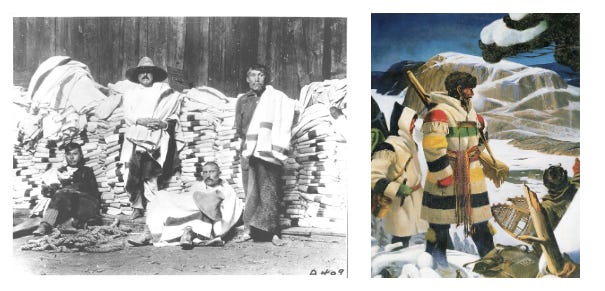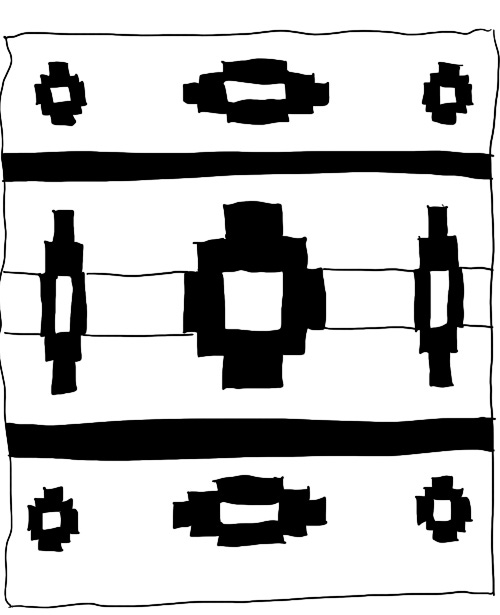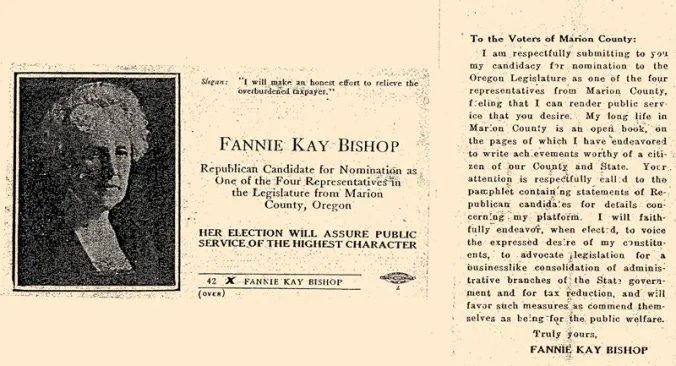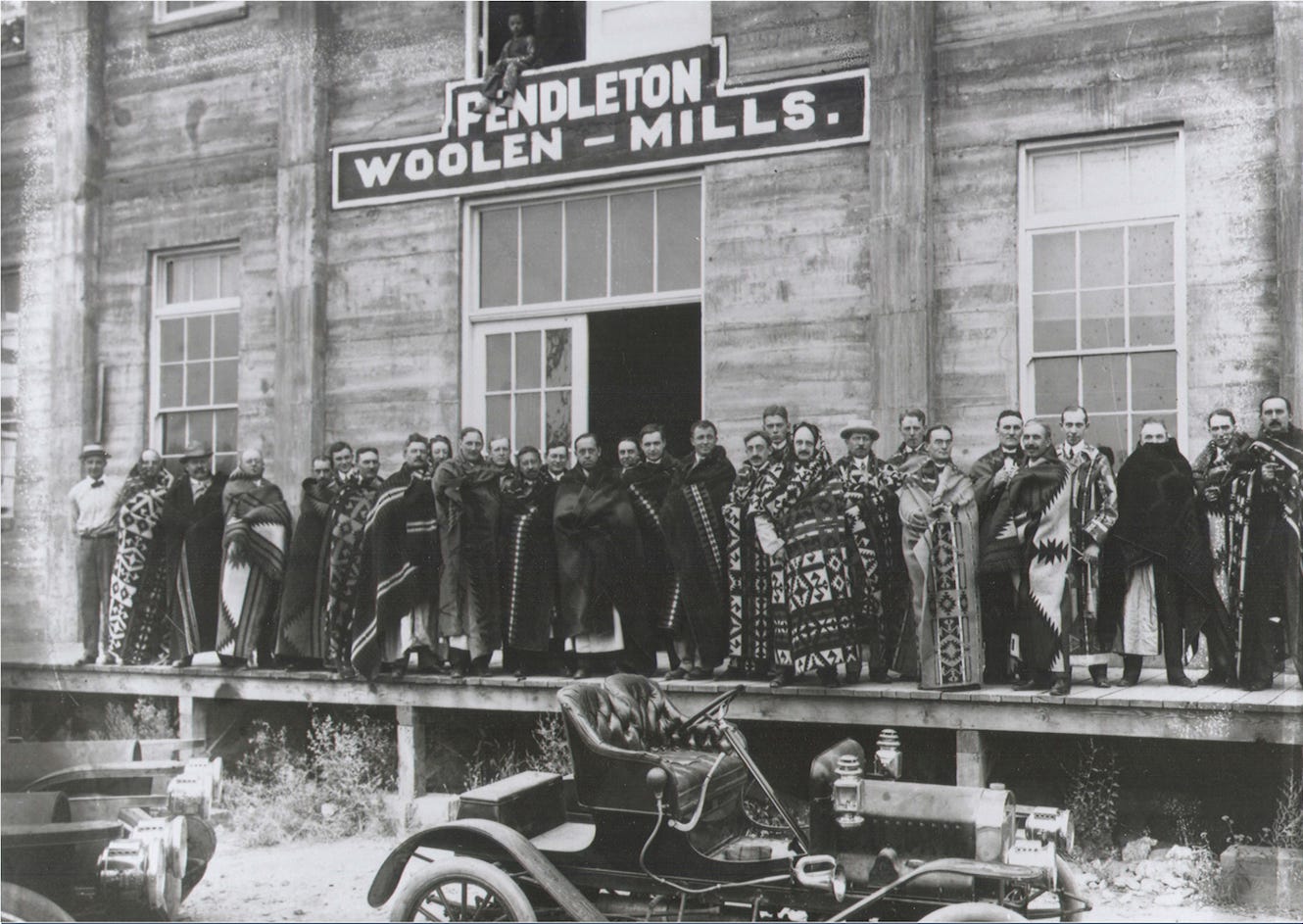Blankets are so much more than pieces of fabric that keep you warm. They can be currency, art and inspiration. Let’s dive in!
There are two main types of antique/historical blankets; trade blankets, which are always wool, and camp blankets, which are always cotton. Camp blankets were much cheaper to produce, so many more of them were made. While historically less popular and less widely available, trade blankets have a more interesting history. So “wrap up” and let’s “unfold” two of the most recognizable types of trade blankets: Pendleton Trade Blankets and Hudson’s Bay Point Blankets.
Pendleton Trade Blankets
I began to “consider” blankets while shivering on my sofa the other week during a bout of bad weather in Toronto. The vibrant patterns and long history of the company made Pendleton stand out in my mind, so they were my first stop on the research train. They did not disappoint. After speaking to Barry Friedman, the leading collector of “Indian Trade & Camp Blankets,” I knew there was a lot of interesting lessons to be uncovered.
Historically, the United States exported cotton to Britain to be weaved into fabrics and then sold to the world (and back to the United States). In 1863, Thomas Kay was a British weaver who moved to the United States to open a mill. Starting as a bobbin boy in Britain (side note: another famous bobbin boy was Andrew Carnegie), he moved to the US and produced the first bolt of worsted wool west of the Mississippi. You can still visit his mill, which is now the Willamette Heritage Center.
His daughter, Fannie, is a fascinating woman. She became his apprentice and learned by his side starting at age 15. Her corporate biography includes this quote from her: “I spent all my spare time in what to me was the fascinating pursuit of learning all about the woolen mill”. She later married Charles P. Bishop, a local merchant. In 1922, only 2 years after women were granted the right to vote, she ran for office in Marion County.
Her and Charles had three sons who opened the Pendleton Woolen Mill in Pendleton, Oregon, in 1909. The location had been scouted by her, and she encouraged her sons to make use of the existing building, the nearby Columbia River, and the supply of high quality wool fleece available from local sheep ranchers.
The factory began producing trade blankets. After the American Indian Wars forced the relocation of Indigenous communities to reservation, enterprising settlers would build trading posts where they would trade manufactured goods for the crafts and production of the Indigenous communities. They did not produce wool blankets. Only the Pueblo and Navajo Indians made sheep’s wool blankets. As well, with the lack of commercially available dyes, any textile production was very time consuming. Think of all the beetles you’d have to find and smash to make enough red dye for a blanket!
The Indigenous communities had weaving experience and with the rise in popularity of rugs in American homes in the early 1890s, the traders encouraged this rug production and would trade rugs for blankets. These blankets would be made by white owned woolen mills, like Pendleton, in patterns that appealed to the Indigenous communities they traded with. Pendleton was not the first to create blankets for this purpose (that was J. Capps & Sons), but they became the most prominent. To date, half the blanket production of Pendleton still goes to native American communities.
HBC Point Blankets
While the Hudson’s Bay Company “Point Blankets” are an emblem of Canada’s colonial history and mistreatment of Indigenous populations, they can still be found in one form or another in many Canadian houses either as blankets, wall-hangings, or re-purposed into pillows, ponchos or other items. They earned their name from the thin black lines stitched on the corner of the blanket, which indicated the size of the blankets (from 1-4). Fur traders would set the value of the blankets and trade with Indigenous populations for pelts, with the rates set by the rarity of the animals being hunted.
The point blanket was actually not a product invented or manufactured by the Hudson’s Bay Company. They would purchase commercially available point blankets and import them to North America for trading. By 1700, blankets were on the other side of 60% of all fur trades.

In 1779 a fur trader named Germain Maugenest suggested that the company make its own blankets. Witney Mills, in Oxfordshire England, was commissioned to make the first ones. The blankets continued to be made by third party mills and were originally made in plain red, white, green or blue wool, with a single bar of indigo on either end. Gradually, over time, design changes were made to cater to the changing tastes of the Indigenous communities. Pure white blankets were made for the Inuit, who liked their use as camouflage. Other communities preferred more colourful patterns, like those made in the United States. The current design of white with four colour stripes did not become available until the late 19th century.
Buying and Storing Blankets
Currently HBC blankets are made by Hainsworth, in West Yorkshire England and start at $300. Used versions should not cost more than $100. Hainsworth is an interesting company in and of itself. They make suiting fabrics, pool table felt and also invented the modern fire fighters coat. If you prefer a “made in Canada” alternative, I recommend MacAusland Wooollen Mills Ltd.. Their Queen-sized all wool blankets start at $150. When I ordered a blanket from them a few years back, they invited me to visit the sheep at a local agricultural fair before it was sheared, and the blanket was shipped in a cardboard Molson Export box. 10/10 service. The blankets are great quality too.
A new Pendleton blanket starts at $300USD. In classic Considered fashion, it is worth exploring the vintage market. Barry will happily sell you a 100 year old blanket for $500 and the best specimens rarely fetch over $1,000USD. Trade blankets are set to have a moment with the western wear revival. In addition to being “Ralph Lauren’s Blanket Guy,” Barry also supplied 60 blankets to Martin Scorsese’s upcoming production Killers of the Flower Moon.
Wondering how best to store these potential heirlooms so that they can be used for decades and even centuries? Like most fabric items, blankets can grow mold and mildew if they are left somewhere damp. Wool also attracts moths and other critters. The original solution for this was the blanket chest. These were made out of cedar and had deep drawers to accommodate large blankets. The modern solution is polyethylene plastic bags (avoid PVC) that look like giant ziplock bags. Just dry and air out your blankets before putting them away for the season.
Thats a wrap!
PS:
Pendleton is not only famous for it’s blankets, it is also famous for its wool plaid shirting. In the 1960s, the plaid shirts became popular with surfers who would wear them to stay warm at the beach. They were so popular among the “beach boys” that The Beach Boys were originally called The Pendletons. You can see them wearing the iconic toppers on the cover of their album Surfing Safari.









The Hudson Bay baby blanket was my go to ‘Canadiana’ baby gift until they changed the quality and fabrication of the product…too bad as it was a great gift to last the test of time and age and could be passed along through the generations…happy I got to gift it while the authenticity was still there…